Statistics: Metal Operators
On This Page
Introduction
The following maps, graphs, and tables present data for Metal Mine Operators. The information is organized by Mines, Employees, Fatalities, and Injuries. The Mines section contains information on the number and location of the mining operations. The Employees section details the number of employees and the number of employee hours. The Fatalities section describes the number and rate of fatalities, the number and rate by work locations, and the number of fatalities by accident class. The Injuries section presents the number and rate of nonfatal lost-time injuries, the number and rate by work locations, and the number of injuries by accident class. Data source: Mine Safety and Health Administration (MSHA). See Statistical Methodology for further details. Additional Mining Facts for each commodity are available from 2000 through 2015.
Mines
 Active Metal Mining Operations, 2015: United States map displaying the locations of active metal mining operations spotted randomly within counties in 2015. Active mines are mining operations that reported mine operator employment during the year. There were 315 metal mines. Mines at which only contractors were working did not show any employment and are not displayed.
Active Metal Mining Operations, 2015: United States map displaying the locations of active metal mining operations spotted randomly within counties in 2015. Active mines are mining operations that reported mine operator employment during the year. There were 315 metal mines. Mines at which only contractors were working did not show any employment and are not displayed.
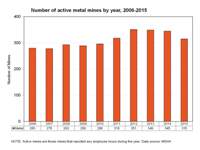 Number of Active Metal Mines by Year, 2006-2015: Graph displaying the number of active mines for a 10-year period from 2006 through 2015. Active mines are those mines that reported any mine operator employee hours during the year. The total number of metal mines has varied with the highest number occurring in 2012 when 351 were reported and the lowest number occurring in 2007 when 278 were reported. In 2015, the number of mines reported was 315.
Number of Active Metal Mines by Year, 2006-2015: Graph displaying the number of active mines for a 10-year period from 2006 through 2015. Active mines are those mines that reported any mine operator employee hours during the year. The total number of metal mines has varied with the highest number occurring in 2012 when 351 were reported and the lowest number occurring in 2007 when 278 were reported. In 2015, the number of mines reported was 315.
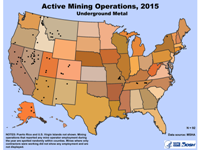 Active Underground Metal Mining Operations, 2015: United States map displaying the locations of active underground metal mining operations spotted randomly within counties in 2015. Active mines are mining operations that reported mine operator employment during the year. There were 92 underground metal mines. Mines at which only contractors were working did not show any employment and are not displayed.
Active Underground Metal Mining Operations, 2015: United States map displaying the locations of active underground metal mining operations spotted randomly within counties in 2015. Active mines are mining operations that reported mine operator employment during the year. There were 92 underground metal mines. Mines at which only contractors were working did not show any employment and are not displayed.
 Active Surface Metal Mining Operations, 2015: United States map displaying the locations of active surface metal mining operations spotted randomly within counties in 2015. Active mines are mining operations that reported mine operator employment during the year. There were 223 surface metal mines. Mines at which only contractors were working did not show any employment and are not displayed.
Active Surface Metal Mining Operations, 2015: United States map displaying the locations of active surface metal mining operations spotted randomly within counties in 2015. Active mines are mining operations that reported mine operator employment during the year. There were 223 surface metal mines. Mines at which only contractors were working did not show any employment and are not displayed.
Employees
 Metal Mine Operator Employees, 2015: United States map displaying employment density by county of the 41,459 metal mine operator employees in 2015. A graduated color ramp is used to symbolize densities of less than 25 employees, 25 to 49 employees, 50 to 199 employees, 200 to 499 employees, and 500 or more employees.
Metal Mine Operator Employees, 2015: United States map displaying employment density by county of the 41,459 metal mine operator employees in 2015. A graduated color ramp is used to symbolize densities of less than 25 employees, 25 to 49 employees, 50 to 199 employees, 200 to 499 employees, and 500 or more employees.
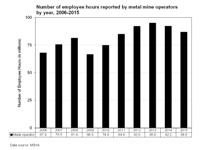 Number of Employee Hours Reported by Metal Mine Operators by Year, 2006-2015: Graph displays the number of metal mine operator employee hours reported from 2006 through 2015. The employee hours increased steadily from 67.9 million in 2006 to 81.4 million hours in 2008. After a decline to 66.5 million hours in 2009, the hours increased to a high of 95.0 million employee hours in 2013. In 2015, employee hours decreased to 86.8 million hours.
Number of Employee Hours Reported by Metal Mine Operators by Year, 2006-2015: Graph displays the number of metal mine operator employee hours reported from 2006 through 2015. The employee hours increased steadily from 67.9 million in 2006 to 81.4 million hours in 2008. After a decline to 66.5 million hours in 2009, the hours increased to a high of 95.0 million employee hours in 2013. In 2015, employee hours decreased to 86.8 million hours.
 Number of Employee Hours Reported by Metal Mine Operators at Underground Work Locations by Year, 2006-2015: Graph displaying the number of underground metal mine operator employee hours reported from 2006 through 2015. The employee hours increased steadily from 9.1 million in 2006 to 11.7 million hours in 2008. After a decline to 9.3 million hours in 2009, the hours increased to a high of 14.0 million employee hours in 2013. In 2015, employee hours slightly decreased to 13.0 million hours.
Number of Employee Hours Reported by Metal Mine Operators at Underground Work Locations by Year, 2006-2015: Graph displaying the number of underground metal mine operator employee hours reported from 2006 through 2015. The employee hours increased steadily from 9.1 million in 2006 to 11.7 million hours in 2008. After a decline to 9.3 million hours in 2009, the hours increased to a high of 14.0 million employee hours in 2013. In 2015, employee hours slightly decreased to 13.0 million hours.
 Number of Employee Hours Reported by Metal Mine Operators at Surface Work Locations by Year, 2006-2015: Graph displays the number of surface metal mine operator employee hours reported from 2006 through 2015. The employee hours increased steadily from 58.8 million in 2006 to 69.7 million hours in 2008. After a decline to 57.3 million hours in 2009, the hours increased to a high of 81.0 million employee hours in 2013. In 2015, employee hours decreased to 73.8 million hours.
Number of Employee Hours Reported by Metal Mine Operators at Surface Work Locations by Year, 2006-2015: Graph displays the number of surface metal mine operator employee hours reported from 2006 through 2015. The employee hours increased steadily from 58.8 million in 2006 to 69.7 million hours in 2008. After a decline to 57.3 million hours in 2009, the hours increased to a high of 81.0 million employee hours in 2013. In 2015, employee hours decreased to 73.8 million hours.
Fatalities
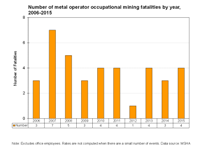 Number of Metal Operator Occupational Mining Fatalities by Year, 2006-2015: Graph displays the number of occupational mining fatalities, excluding office employees, from 2006 through 2015. Rates are not computed when there are a small number of events. Over the period, the number of fatalities varied from a high of 7 in 2007, to a low of 1 fatality in 2012. In 2015, the number of fatalities was 4.
Number of Metal Operator Occupational Mining Fatalities by Year, 2006-2015: Graph displays the number of occupational mining fatalities, excluding office employees, from 2006 through 2015. Rates are not computed when there are a small number of events. Over the period, the number of fatalities varied from a high of 7 in 2007, to a low of 1 fatality in 2012. In 2015, the number of fatalities was 4.
Injuries
 Nonfatal Lost-time Injuries, 2015 (Metal Mine Operators and Independent Contractors): Map of the United States displaying nonfatal lost-time injury density by county for 722 metal mine operator and contractor injuries during 2015. Office workers are excluded. A graduated color ramp is used to symbolize densities of zero injuries, 1 to 9, 10 to 29, 30 to 49, and 50 or more injuries.
Nonfatal Lost-time Injuries, 2015 (Metal Mine Operators and Independent Contractors): Map of the United States displaying nonfatal lost-time injury density by county for 722 metal mine operator and contractor injuries during 2015. Office workers are excluded. A graduated color ramp is used to symbolize densities of zero injuries, 1 to 9, 10 to 29, 30 to 49, and 50 or more injuries.
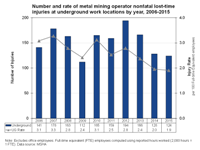 Number and Rate of Metal Mining Operator Nonfatal Lost-time Injuries at Underground Work Locations by Year, 2006-2015: Graph displays the number and rate of metal mining operator nonfatal lost-time injuries at underground work locations, excluding office employees, from 2006 through 2015. Full-time equivalent (FTE) employees are based on 2,000 employee hours worked per year. The rates and numbers have varied over the period. The highest rate saw 3.3 nonfatal lost-time injuries per 100 FTEs in 2007 and the lowest rate was 2.0 in 2014. The highest number of injuries occurred in 2012 when 194 were reported and the lowest number in 2009 with 112 injuries reported.
Number and Rate of Metal Mining Operator Nonfatal Lost-time Injuries at Underground Work Locations by Year, 2006-2015: Graph displays the number and rate of metal mining operator nonfatal lost-time injuries at underground work locations, excluding office employees, from 2006 through 2015. Full-time equivalent (FTE) employees are based on 2,000 employee hours worked per year. The rates and numbers have varied over the period. The highest rate saw 3.3 nonfatal lost-time injuries per 100 FTEs in 2007 and the lowest rate was 2.0 in 2014. The highest number of injuries occurred in 2012 when 194 were reported and the lowest number in 2009 with 112 injuries reported.
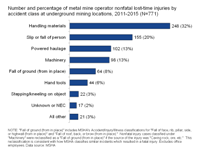 Number and Percentage of Metal Mine Operator Nonfatal Lost-time Injuries by Accident Class at Underground Mining Locations, 2011-2015: Graph displaying the distribution of nonfatal lost-time injuries by accident class for metal operators at underground mining locations for the period from 2011 through 2015. Excluding office employees, there were a total of 771 lost-time injuries. Percentages are as follows, "Handling materials“ saw 32%, "Slip or fall of person" 20%, “Powered haulage” and "Machinery“ both reported 13% of the nonfatal lost-time injuries. Nonfatal injury cases classified under machinery were reclassified as a fall of ground (from in place) if the source of the injury was caving rock, ore, etc. This reclassification is consistent with how MSHA classifies similar incidents which resulted in a fatal injury. "Fall of ground (from in place)", which includes MSHA’s Accident/Injury/Illness Classifications for “Fall of face, rib, pillar, side, or highwall from in place” and “Fall of roof, back, or brow from in place,” reported 8%, “Hand tools” 6%, “Stepping/kneeling on object” 3%, “Unknown or NEC” 2%, and the "All other" category accounted for 3% of the nonfatal lost-time injuries during the 5-year period. Note that the sum of percentages may not equal 100 due to independent rounding.
Number and Percentage of Metal Mine Operator Nonfatal Lost-time Injuries by Accident Class at Underground Mining Locations, 2011-2015: Graph displaying the distribution of nonfatal lost-time injuries by accident class for metal operators at underground mining locations for the period from 2011 through 2015. Excluding office employees, there were a total of 771 lost-time injuries. Percentages are as follows, "Handling materials“ saw 32%, "Slip or fall of person" 20%, “Powered haulage” and "Machinery“ both reported 13% of the nonfatal lost-time injuries. Nonfatal injury cases classified under machinery were reclassified as a fall of ground (from in place) if the source of the injury was caving rock, ore, etc. This reclassification is consistent with how MSHA classifies similar incidents which resulted in a fatal injury. "Fall of ground (from in place)", which includes MSHA’s Accident/Injury/Illness Classifications for “Fall of face, rib, pillar, side, or highwall from in place” and “Fall of roof, back, or brow from in place,” reported 8%, “Hand tools” 6%, “Stepping/kneeling on object” 3%, “Unknown or NEC” 2%, and the "All other" category accounted for 3% of the nonfatal lost-time injuries during the 5-year period. Note that the sum of percentages may not equal 100 due to independent rounding.
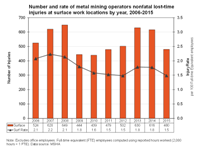 Number and Rate of Metal Mining Operators Nonfatal Lost-time Injuries at Surface Work Locations by Year, 2006-2015: Graph displays the number and rate of metal mining operator nonfatal lost-time injuries at surface work locations, excluding office employees, from 2006 through 2015. Full-time equivalent (FTE) employees are based on 2,000 employee hours worked per year. The rates and numbers have varied over the period with rates ranging from 2.1 in 2006 to 1.5 per 100 FTE’s in 2015. The highest number of injuries occurred in 2008 when 649 were reported and the lowest in 2010 with 439 injuries reported.
Number and Rate of Metal Mining Operators Nonfatal Lost-time Injuries at Surface Work Locations by Year, 2006-2015: Graph displays the number and rate of metal mining operator nonfatal lost-time injuries at surface work locations, excluding office employees, from 2006 through 2015. Full-time equivalent (FTE) employees are based on 2,000 employee hours worked per year. The rates and numbers have varied over the period with rates ranging from 2.1 in 2006 to 1.5 per 100 FTE’s in 2015. The highest number of injuries occurred in 2008 when 649 were reported and the lowest in 2010 with 439 injuries reported.
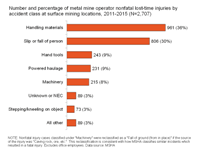 Number and Percentage of Metal Mine Operator Nonfatal Lost-time Injuries by Accident Class at Surface Mining Locations, 2011-2015: Graph displays the distribution of nonfatal lost-time injuries by accident class for metal operators at surface mining locations for the period from 2011 through 2015. Excluding office employees, there were a total of 2,707 lost-time injuries. "Handling materials" had 36% and "Slip or fall of person" had 30% of the nonfatal lost-time injuries. "Hand tools“ and "Powered haulage" reported 9% each and "Machinery" accounted for 8% of the total. Nonfatal injury cases classified under machinery were reclassified as a fall of ground (from in place) if the source of the injury was caving rock, ore, etc. This reclassification is consistent with how MSHA classifies similar incidents which resulted in a fatal injury. The “Unknown or NEC” category, the “Stepping/kneeling on object category and the "All other" category all accounted for 3% of nonfatal lost-time injuries during the 5-year period. Note that the sum of percentages may not equal 100 due to independent rounding.
Number and Percentage of Metal Mine Operator Nonfatal Lost-time Injuries by Accident Class at Surface Mining Locations, 2011-2015: Graph displays the distribution of nonfatal lost-time injuries by accident class for metal operators at surface mining locations for the period from 2011 through 2015. Excluding office employees, there were a total of 2,707 lost-time injuries. "Handling materials" had 36% and "Slip or fall of person" had 30% of the nonfatal lost-time injuries. "Hand tools“ and "Powered haulage" reported 9% each and "Machinery" accounted for 8% of the total. Nonfatal injury cases classified under machinery were reclassified as a fall of ground (from in place) if the source of the injury was caving rock, ore, etc. This reclassification is consistent with how MSHA classifies similar incidents which resulted in a fatal injury. The “Unknown or NEC” category, the “Stepping/kneeling on object category and the "All other" category all accounted for 3% of nonfatal lost-time injuries during the 5-year period. Note that the sum of percentages may not equal 100 due to independent rounding.
See Also
- Metal and Nonmetal Industry Sector
- Metal Operator Mining Facts - 2002
- Metal Operator Mining Facts - 2004
- Mining Fact Sheets
- Mining Facts - 2015
- Noncoal Contractor Mining Facts - 2003
- Nonmetal Operator Mining Facts - 2002
- Nonmetal Operator Mining Facts - 2008
- Sand and Gravel Operator Mining Facts - 2006
- Statistical Methodology
- Statistics: Coal Operators
- Statistics: Nonmetal Operators
- Stone Operator Mining Facts - 2003
- Stone Operator Mining Facts - 2005
- Page last reviewed: 4/11/2017
- Page last updated: 4/11/2017
- Content source: National Institute for Occupational Safety and Health, Mining Program


 ShareCompartir
ShareCompartir